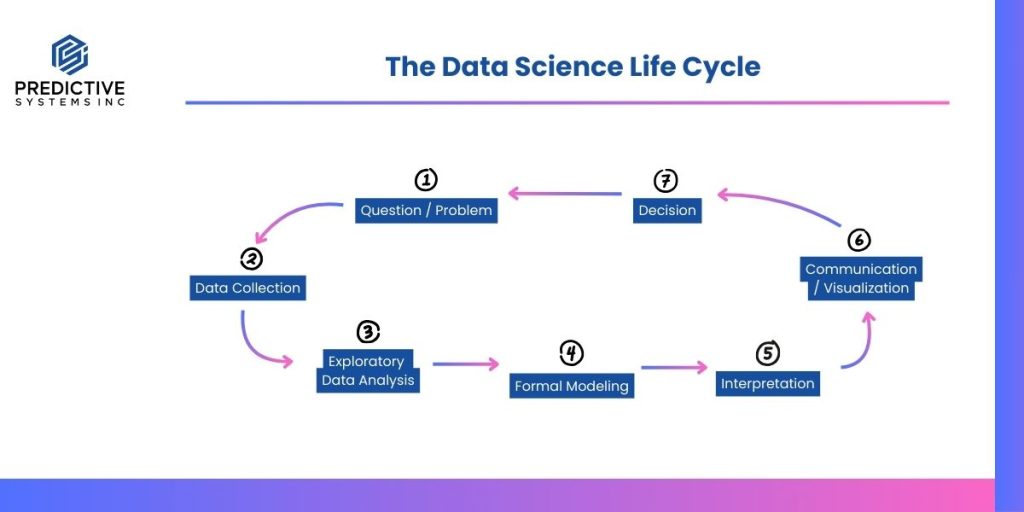Data science and machine learning projects are powerful tools for solving business problems, but to execute them effectively, you need a clear roadmap. Understanding the lifecycle of a typical data science project is crucial for designing, developing, and deploying AI systems that deliver tangible results.
In this article, we’ll walk you through the seven key steps of the data science project lifecycle and explore how to blend business acumen with technical skills to ensure your AI initiatives succeed.
1. Understanding the Business Problem
The first and most critical step in any data science project is to understand the business problem you’re solving. Without a clear problem definition, your project risks becoming misaligned with business objectives, leading to wasted resources and effort.
- Why it matters: This step ensures that your data science efforts are grounded in real-world impact, aligning your solutions with business goals.
- How to do it: Collaborate with stakeholders to define the problem and identify success metrics. Ask key business questions, such as: What problem are we solving? How important is this problem to the business? For example, determining where to open a new branch might involve analyzing customer demographics, competitor presence, and market trends.
- Pitfalls to avoid: Vague objectives or misaligned goals can derail your project. Make sure the problem is specific and directly tied to business strategy.
2. Data Collection
Once the business problem is defined, you need the right data to support your analysis. Data collection is about gathering relevant, accurate, and sufficient data from internal or external sources.
- Why it matters: Without quality data, even the best models can’t deliver accurate insights.
- How to do it: Assess internal data (e.g., sales records) and external sources (e.g., social media, Google Maps) that provide valuable insights. Always check for data quality, ensuring completeness, accuracy, and consistency.
- Pitfalls to avoid: Incomplete or biased data can lead to unreliable results. Ensure you address any missing values and be mindful of potential biases that could skew your analysis.
3. Exploratory Data Analysis (EDA)
With your data collected, the next step is exploratory data analysis (EDA), where you dig into the data to uncover patterns, identify outliers, and formulate hypotheses.
- Why it matters: EDA helps you understand the structure of the data, setting the stage for effective modeling.
- How to do it: Use data visualization tools like Matplotlib or Seaborn to explore distributions and correlations. Handle missing data thoughtfully and consider normalizing data to improve analysis.
- Pitfalls to avoid: Ignoring outliers or correlations can distort your analysis. Address these early to ensure your models are robust.
4. Formal Modeling
Modeling is where data is transformed into actionable insights. Choosing the right model is critical to solving the business problem effectively.
- Why it matters: The accuracy and applicability of your AI solution depend on the model you select.
- How to do it: Experiment with various algorithms—like linear regression, decision trees, or neural networks—and use techniques like k-fold cross-validation to validate your model’s performance. Focus on feature engineering to boost model performance by creating new features from existing data.
- Pitfalls to avoid: Be cautious of overfitting (when the model works well on training data but poorly on new data) or underfitting (when the model is too simplistic). Use regularization techniques to find the right balance.
5. Interpretation
Once your model is built, the next step is to interpret the results and translate them into business insights.
- Why it matters: Business leaders rely on your interpretations to make data-driven decisions. Your findings must be accurate and actionable.
- How to do it: Evaluate the model using metrics like precision, recall, and ROC-AUC, then explain the results in terms of business impact. Avoid overwhelming stakeholders with technical jargon—translate findings into business language they can understand.
- Pitfalls to avoid: Misinterpreting the results or focusing solely on accuracy can lead to flawed conclusions. Always consider the broader business context, including trade-offs like false positives vs. false negatives.
6. Communication and Visualization
Effective communication and visualization of your findings is crucial to ensure that stakeholders can make informed decisions based on your analysis.
- Why it matters: Without clear communication, even the most insightful analysis can be overlooked or misunderstood.
- How to do it: Use storytelling techniques to present data in an engaging way. Leverage tools like Tableau or Power BI to create visualizations that make complex data easy to grasp. Tailor your presentation to your audience, focusing on the key insights that matter most to them.
- Pitfalls to avoid: Don’t overwhelm your audience with too much information. Keep your presentation focused on the insights that drive decisions, and provide the necessary context to avoid misinterpretation.
7. Decision
Finally, your project delivers value when stakeholders make decisions based on your analysis. The decision-making phase ties everything together.
- Why it matters: The ultimate goal of any data science project is to provide insights that drive actionable business decisions.
- How to do it: Present clear, actionable recommendations based on your findings, and be prepared to answer any questions. Discuss ethical considerations, especially if your project deals with sensitive data.
- Pitfalls to avoid: Some stakeolders may resist change, especially if the insights suggest a new direction. Be ready to address concerns and provide reassurance with solid data-backed reasoning.

Combining Business Acumen and Technical Skills
Successfully navigating a data science or machine learning project requires more than technical expertise—you need a deep understanding of the business problem you’re solving and the ability to communicate your findings effectively. By following this structured project lifecycle, you can ensure your AI initiatives deliver real business value.
At Predictive Systems Inc., we specialize in helping businesses leverage AI to solve their most pressing challenges. Contact us today to learn how we can help you design, develop, and deploy AI systems tailored to your unique business needs.


